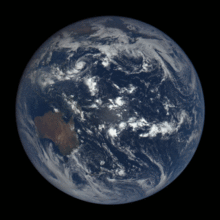Rotation period (astronomy)
(Redirected from
Rotation period
)
In
synodic rotation period (or solar day), which may differ, by a fraction of a rotation or more than one rotation, to accommodate the portion of the object's orbital period
around a star or another body during one day.
Measuring rotation
For solid objects, such as rocky
conservation of angular momentum), it is not necessarily fixed in the body of the object itself.[citation needed] As a result of this, the moment of inertia of the object around the rotation axis can vary, and hence the rate of rotation can vary (because the product of the moment of inertia and the rate of rotation is equal to the angular momentum, which is fixed). For example, Hyperion, a moon of Saturn, exhibits this behaviour, and its rotation period is described as chaotic
.
Rotation period of selected objects
| Celestial objects | Rotation period with respect to distant stars, the sidereal rotation period (compared to Earth's mean Solar days) | Synodic rotation period (mean Solar day) |
Apparent rotational period viewed from Earth | |
|---|---|---|---|---|
| Sun* | 25.379995 days ( Carrington rotation )35 days (high latitude) |
25d 9h 7m 11.6s 35d |
~28 days (equatorial)[2] | |
| Mercury | 58.6462 days[3] | 58d 15h 30m 30s | 176 days[4] | |
| Venus | −243.0226 days[5][6] | −243d 0h 33m | −116.75 days[7] | |
| Earth | 0.99726968 days[3][8] | 0d 23h 56m 4.0910s | 1.00 days (24h 00m 00s) | |
| Moon | 27.321661 days sidereal lunar month ) |
27d 7h 43m 11.5s | 29.530588 days synodic lunar month ) |
none (due to spin-orbit locking) |
| Mars | 1.02595675 days[3] | 1d 0h 37m 22.663s | 1.02749125[10] days | |
| Ceres | 0.37809 days[11] | 0d 9h 4m 27.0s | 0.37818 days | |
| Jupiter | 0.41354 days(average) 0.4135344 days (deep interior[12]) 0.41007 days (equatorial) 0.4136994 days (high latitude) |
0d 9h 55m 30s[3] 0d 9h 55m 29.37s[3] 0d 9h 50m 30s[3] 0d 9h 55m 43.63s[3] |
0.41358 d (9 h 55 m 33 s)[13] (average) | |
| Saturn | 0.44002+0.00130 −0.00091 days (average, deep interior[14]) 0.44401 days (deep interior[12]) 0.4264 days (equatorial) 0.44335 days (high latitude) |
10h 33m 38s + 1m 52s − 1m 19s [15][16] 0d 10h 39m 22.4s[17] 0d 10h 13m 59s[18] 0d 10h 38m 25.4s[18] |
0.43930 d (10 h 32 m 36 s)[13] | |
| Uranus | −0.71833 days[3][5] | −0d 17h 14m 24s | −0.71832 d (−17 h 14 m 23 s)[13] | |
| Neptune | 0.67125 days[3] | 0d 16h 6m 36s | 0.67125 d (16 h 6 m 36 s)[13] | |
| Pluto | −6.38718 days[3][5] |
–6d 9h 17m 32s | −6.38680 d (–6d 9h 17m 0s)[13] | |
Haumea |
0.1631458 ±0.0000042 days[19] | 0d 3h 56m 43.80 ±0.36s | 0.1631461 ±0.0000042 days | |
| Makemake | 0.9511083 ±0.0000042 days[20] | 22h 49m 35.76 ±0.36s | 0.9511164 ±0.0000042 days | |
| Eris | ~1.08 days[21] | 25h ~54m | ~1.08 days | |
* See Solar rotation for more detail.
See also
- Apparent retrograde motion
- Day length fluctuations
- Earth's rotation periods
- List of slow rotators (minor planets)
- List of fast rotators (minor planets)
- Retrograde motion
- Rotation (astronomy)
- Rotational speed
- Stellar rotation
- Synodic day
References
- ^ "Period". COSMOS - The SAO Encyclopedia of Astronomy. Retrieved 2023-08-03.
- ISBN 978-0-521-39788-9.
- ^ ISBN 0-387-98746-0.
- ^ "ESO". ESO. Retrieved 2021-06-03.
- ^ a b c This rotation is negative because the pole which points north of the invariable plane rotates in the opposite direction to most other planets.
- S2CID 232092194.
- ^ "How long is a day on Venus?". TE AWAMUTU SPACE CENTRE. Retrieved 2021-06-03.
- SIseconds.
- ^ ISBN 0-387-98746-0.
- ^ Allison, Michael; Schmunk, Robert. "Mars24 Sunclock — Time on Mars". NASA GISS.
- .
- ^ a b Rotation period of the deep interior is that of the planet's magnetic field.
- ^ a b c d e Seligman, Courtney. "Rotation Period and Day Length". Retrieved June 12, 2021.
- ^ Found through examination of Saturn's C Ring
- ^ McCartney, Gretchen; Wendel, JoAnna (18 January 2019). "Scientists Finally Know What Time It Is on Saturn". NASA. Retrieved 18 January 2019.
- S2CID 67840660.
- S2CID 44313317.
- ^ ISBN 978-1-4614-7018-2.
- S2CID 115712870. Retrieved 2008-09-22.
- S2CID 102350991.
- ^ "JPL Small-Body Database Browser: 136199 Eris (2003 UB313)" (December 14, 2019, solution date). Archived from the original on April 12, 2016. Retrieved February 20, 2020.
External links
- Murray, Carl D. & Dermott, Stanley F. (1999). Solar System Dynamics. in this work may be inaccurate.
